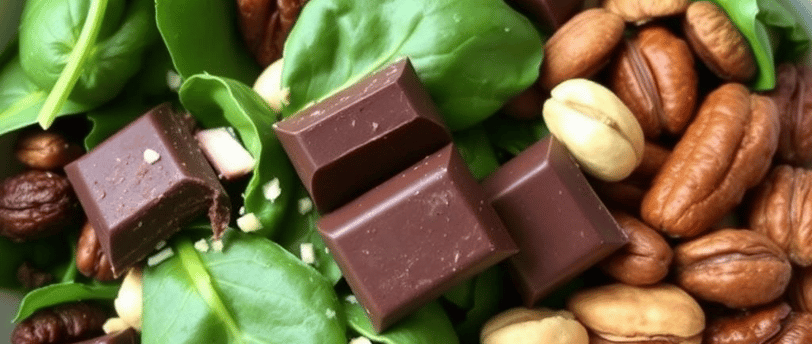Prioritize Magnesium for PMS Relief: Found in Dark Chocolate, Bananas, and Leafy Greens
🧘WELLNESS TIPS🌸 HORMONAL BALANCE & WOMEN’S WELLNESS


Premenstrual syndrome (PMS) is a common condition that affects many menstruating individuals, bringing with it a myriad of symptoms ranging from mood swings and irritability to physical discomfort like cramps and bloating. While various treatments are available, including lifestyle modifications and medications, there is growing scientific evidence that suggests dietary approaches, specifically increasing magnesium intake, can significantly alleviate PMS symptoms. This article explores the benefits of magnesium and its sources such as dark chocolate, bananas, and leafy greens.
Understanding PMS and Its Impact
PMS affects an estimated 50% to 80% of individuals with menstrual cycles, with approximately 5% experiencing severe symptoms that interfere with daily life. The spectrum of symptoms can include emotional changes such as anxiety and depression, as well as physical symptoms like fatigue, swelling, and abdominal pain. The exact cause of PMS remains unclear, but hormonal fluctuations, particularly involving estrogen and progesterone, are believed to play a crucial role.
The impact of PMS on quality of life can be profound. Many individuals report decreased productivity at work or school, strained personal relationships, and challenges in managing their daily activities. It is within this context that magnesium emerges as a vital candidate for addressing PMS symptoms.
The Role of Magnesium in the Body
Magnesium is an essential mineral involved in over 300 biochemical reactions in the body. It plays critical roles in muscle function, nerve function, energy production, and the regulation of mood. Interestingly, magnesium has also been linked to hormonal balance and neurotransmitter function, making it a crucial player in managing PMS.
Scientific Evidence Supporting Magnesium’s Role in PMS Relief
Recent research has provided compelling evidence about magnesium's potential in alleviating PMS symptoms. Multiple studies have demonstrated a correlation between low magnesium levels and increased PMS severity. One study published in the Journal of Obstetrics and Gynaecology showed that women with severe PMS had significantly lower magnesium levels compared to those with milder symptoms or no PMS at all.
Furthermore, a meta-analysis published in The Journal of Clinical Endocrinology & Metabolism found that magnesium supplementation was effective in reducing the psychological and physical symptoms of PMS. Participants who took magnesium supplements reported decreased anxiety, improved mood, and reduced physical discomfort. The scientists concluded that magnesium could play a vital role in managing PMS symptoms, particularly in populations at risk of deficiency.
Why Magnesium May Be Effective for PMS
Several mechanisms have been proposed to explain how magnesium may alleviate PMS symptoms:
Regulation of Hormones: Magnesium is known to contribute to the synthesis of hormones and supports adrenal function, which is crucial during the menstrual cycle. It may help regulate the balance of hormones such as estrogen and progesterone, potentially relieving mood swings and emotional PMS symptoms.
Nervous System Support: Magnesium is essential for the normal functioning of the nervous system. It plays a role in neurotransmitter regulation, influencing mood and anxiety levels. This support can help mitigate the emotional distress often associated with PMS.
Reduction of Inflammation: Scientific evidence suggests that magnesium has anti-inflammatory properties. By reducing inflammation, magnesium may alleviate symptoms such as cramps and bloating that many experience during PMS.
Muscle Relaxation: Magnesium is known for its muscle-relaxing properties, which can help alleviate the cramps often associated with PMS. By promoting relaxation and reducing muscle tension, individuals may find relief from the physical manifestations of PMS.
Magnesium-Rich Foods to Consider
Incorporating magnesium-rich foods into your diet is an excellent way to boost your intake naturally. Some delicious and easily available sources include:
Dark Chocolate
Dark chocolate is not only a treat but also a fantastic source of magnesium. With roughly 50-80 mg of magnesium per ounce, it is a delightful way to satisfy sweet cravings while potentially reducing PMS symptoms. Beyond magnesium, dark chocolate is rich in antioxidants and has other health benefits, including potential mood enhancement.
Bananas
Bananas are known for their potassium content, but they also provide a significant amount of magnesium—about 32 mg per medium banana. This fruit is incredibly versatile and can be enjoyed in various ways, such as in smoothies, oatmeal, or as a quick snack on the go.
Leafy Greens
Leafy greens such as spinach, kale, and Swiss chard are not only healthy but also packed with magnesium. A single cup of cooked spinach contains approximately 157 mg of magnesium. These greens can easily be incorporated into salads, soups, or as sides to your meals.
Other Magnesium Sources
In addition to the above foods, consider including nuts and seeds, legumes, whole grains, and avocados in your diet. These foods are not only rich in magnesium but also provide other essential nutrients that promote overall health and well-being.
How to Increase Magnesium Intake
While food sources are the best way to increase magnesium intake, supplements are also an option for those unable to meet their daily requirements through diet alone. However, it’s advisable to consult with a healthcare professional before starting any supplementation. They can assess your specific needs and recommend appropriate dosages.
Recommended Daily Allowance
The recommended dietary allowance (RDA) for magnesium varies by age and gender. Adult women, for instance, require approximately 310-320 mg daily, while men need around 400-420 mg. Ensuring you meet these daily requirements can be beneficial not just for PMS relief but for overall health.
Conclusion
Considering the substantial scientific evidence linking magnesium to PMS relief, it may be time to prioritize this essential mineral in your diet. By incorporating magnesium-rich foods like dark chocolate, bananas, and leafy greens into your meals, you may find significant relief from the distressing symptoms associated with PMS. Remember, dietary changes may take some time to show results, and it’s essential to approach PMS relief holistically—combining nutrition, lifestyle modifications, and, if necessary, medical advice. So, the next time you reach for a snack, think of how a little more magnesium can go a long way toward comfort during that time of the month.
